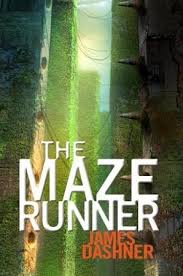
The Maze Runner
Chapter 12
by Dashner, JamesIn Chapter 12 of *The Maze Runner*, Thomas encounters a collapsed Runner named Minho and initially hesitates to help, fearing the boy might be stung or seriously injured. Overcoming his indecision, Thomas calls for assistance and kneels beside Minho, who is exhausted but conscious. Their tense exchange reveals Minho’s abrasive personality as he dismisses Thomas’s concerns and mocks Alby’s authority. Despite Minho’s harsh demeanor, Alby surprisingly obeys his demand for water, hinting at a complex dynamic among the Gladers.
Thomas struggles to understand Minho’s sarcastic and unpredictable behavior, questioning Alby’s leadership role. Minho dismisses Thomas’s inquiries with insults, calling him a “Greenie” and telling him to keep quiet. Their interaction oscillates between hostility and camaraderie, leaving Thomas unsure whether to like or resent Minho. The conversation shifts to the mysterious girl in the coma, with Minho teasing Thomas about his connection to her, though Thomas denies recognizing her.
Minho’s exhaustion and cryptic remarks about the Maze pique Thomas’s curiosity. When Thomas presses for details, Minho deflects, insisting on waiting for Alby’s return before sharing his discovery. Despite his frustration, Thomas begins to warm up to Minho, appreciating his blunt honesty. Minho’s eventual revelation that he found a dead Griever in the Maze sets the stage for a significant turning point in the story, leaving Thomas and Alby stunned.
The chapter highlights the tension and camaraderie among the Gladers, particularly through Minho’s volatile personality and Thomas’s growing involvement in their world. Minho’s discovery of a dead Griever introduces a new mystery, suggesting that the Maze’s dangers may be evolving. Thomas’s interactions with Minho and Alby deepen his understanding of the group’s hierarchy and the challenges they face, setting up further intrigue and conflict in the narrative.
FAQs
1. How does Thomas initially react when he sees Minho collapsed, and what does this reveal about his character?
Answer:
Thomas initially freezes in indecision, worrying about potential dangers like the boy being “stung” or seriously injured. This hesitation reveals his cautious nature and survival instincts in the unfamiliar Glade environment. However, he quickly overcomes this fear to help, shouting for Alby and Newt before rushing to Minho’s aid. This shift shows Thomas’s underlying compassion and ability to act decisively when needed, despite his newcomer status and limited understanding of the Glade’s dangers.2. Analyze the power dynamics between Minho, Alby, and Thomas as revealed in their interactions.
Answer:
The chapter reveals complex power dynamics: Alby holds formal leadership (evidenced by Thomas asking “Isn’t he the leader?”), but Minho openly mocks this authority with nicknames like “El Presidente” and commands Alby to fetch water. Alby tolerates this disrespect, suggesting Minho holds special status as a veteran Runner. Thomas challenges Minho’s condescension but ultimately defers, showing the newcomers’ lower social standing. The tension between Minho’s earned authority (as a Runner) and Alby’s positional authority creates an intriguing hierarchy where experience sometimes trumps formal leadership.3. What significant discovery does Minho reveal at the chapter’s end, and why is this development important?
Answer:
Minho reveals he found a dead Griever in the Maze—a unprecedented event in the Gladers’ experience. This is critically important because: 1) It proves Grievers can die, challenging the assumption they’re invincible threats; 2) It may hint at changing Maze dynamics following the girl’s arrival; 3) It could provide clues about defeating the creatures. The chapter builds suspense by withholding details about the Griever’s condition or location, leaving readers to speculate about potential implications for escape attempts.4. How does Minho’s attitude toward Thomas evolve during their conversation, and what does this suggest about their potential relationship?
Answer:
Minho begins aggressively mocking Thomas (“Freakin’ Newbies”), testing his boundaries through insults and power plays. However, after Thomas stands up for himself (“I’m sure that’s exactly what you did as a Newbie”), Minho lightens up, admitting he was “just playin’” and eventually including Thomas in the Griever revelation. This suggests Minho respects those who show backbone, foreshadowing a mentor-apprentice dynamic. Their banter establishes a foundation for future collaboration, particularly as Thomas shows interest in the Runners’ work.5. Why might the author have chosen to end the chapter with the revelation about the dead Griever?
Answer:
This cliffhanger ending serves multiple narrative purposes: 1) It creates immediate suspense about how this discovery will impact the Gladers’ survival strategies; 2) It validates Thomas’s (and readers’) curiosity about the Maze’s mysteries; 3) It parallels the girl’s arrival as another unprecedented event, reinforcing the theme that “everything is going to change”; 4) It rewards attentive readers who recall earlier Griever descriptions while leaving crucial questions unanswered to maintain intrigue. This strategic placement ensures readers will continue to the next chapter.
Quotes
1. “Thomas didn’t move for a few seconds. The boy lay in a crumpled heap, barely moving, but Thomas was frozen by indecision, afraid to get involved.”
This quote captures Thomas’s internal conflict and hesitation when faced with a crisis, showcasing his initial fear and uncertainty in the Glade. It sets the tone for his character development throughout the chapter.
2. “Leader? Yeah, call him leader all you want. Maybe we should call him El Presidente. Nah, nah—Admiral Alby. There you go.”
Minho’s sarcastic remark reveals the complex power dynamics among the Gladers, challenging the notion of Alby’s leadership while also highlighting Minho’s rebellious personality. This exchange provides insight into the social hierarchy of the group.
3. “Do what you’re told, keep your mouth shut. That’s what I expect.”
Minho’s blunt instruction to Thomas represents the harsh survival mentality of the Gladers and the expectations placed on newcomers. This quote underscores the tension between curiosity and obedience in their dangerous environment.
4. “I found a dead one. A dead Griever.”
This climactic revelation at the chapter’s end marks a significant turning point in the story, as it’s the first time a Griever has been found dead. The quote creates suspense and hints at possible changes in the Maze’s dynamics.
